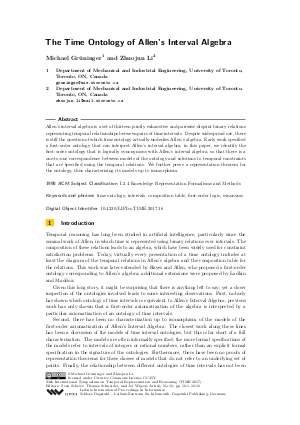The Time Ontology of Allen's Interval Algebra
Authors Michael Grüninger, Zhuojun Li
-
Part of:
Volume:
24th International Symposium on Temporal Representation and Reasoning (TIME 2017)
Part of: Series: Leibniz International Proceedings in Informatics (LIPIcs)
Part of: Conference: International Symposium on Temporal Representation and Reasoning (TIME) - License:
 Creative Commons Attribution 3.0 Unported license
Creative Commons Attribution 3.0 Unported license
- Publication Date: 2017-09-25
File

PDF
LIPIcs.TIME.2017.16.pdf
- Filesize: 0.58 MB
- 16 pages
Document Identifiers
Subject Classification
Keywords
- time ontology
- intervals
- composition table
- first-order logic
- synonymy
Metrics
- Access Statistics
-
Total Accesses (updated on a weekly basis)
0Document
0Metadata
Abstract
Allen's interval algebra is a set of thirteen jointly exhaustive and pairwise disjoint binary relations representing temporal relationships between pairs of timeintervals. Despite widespread use, there is still the question of which time ontology actually underlies Allen's algebra. Early work specified a first-order ontology that can interpret Allen's interval algebra; in this paper, we identify the first-order ontology that is logically synonymous with Allen's interval algebra, so that there is a one-to-one correspondence between models of the ontology and solutions to temporal constraints that are specified using the temporal relations. We further prove a representation theorem for the ontology, thus characterizing its models up to isomorphism.
Cite As Get BibTex
Michael Grüninger and Zhuojun Li. The Time Ontology of Allen's Interval Algebra. In 24th International Symposium on Temporal Representation and Reasoning (TIME 2017). Leibniz International Proceedings in Informatics (LIPIcs), Volume 90, pp. 16:1-16:16, Schloss Dagstuhl – Leibniz-Zentrum für Informatik (2017)
https://doi.org/10.4230/LIPIcs.TIME.2017.16
BibTex
@InProceedings{gruninger_et_al:LIPIcs.TIME.2017.16,
author = {Gr\"{u}ninger, Michael and Li, Zhuojun},
title = {{The Time Ontology of Allen's Interval Algebra}},
booktitle = {24th International Symposium on Temporal Representation and Reasoning (TIME 2017)},
pages = {16:1--16:16},
series = {Leibniz International Proceedings in Informatics (LIPIcs)},
ISBN = {978-3-95977-052-1},
ISSN = {1868-8969},
year = {2017},
volume = {90},
editor = {Schewe, Sven and Schneider, Thomas and Wijsen, Jef},
publisher = {Schloss Dagstuhl -- Leibniz-Zentrum f{\"u}r Informatik},
address = {Dagstuhl, Germany},
URL = {https://drops.dagstuhl.de/entities/document/10.4230/LIPIcs.TIME.2017.16},
URN = {urn:nbn:de:0030-drops-79271},
doi = {10.4230/LIPIcs.TIME.2017.16},
annote = {Keywords: time ontology, intervals, composition table, first-order logic, synonymy}
}
Author Details
References
-
J. Allen and P. Hayes. Moments and points in an interval-based temporal logic. Computational Intelligence, 5:225-238, 1989.

- James F. Allen. Maintaining knowledge about temporal intervals. Commun. ACM, 26(11):832-843, 1983. URL: http://dx.doi.org/10.1145/182.358434.
-
B. Bennett, A. Isli, and A. G. Cohn. When does a composition table provide a complete and tractable proof procedure for a relational constraint language? In Proceedings of the IJCAI-97 workshop on Spatial and Temporal Reasoning, 1997.

-
J. . Logic of Time. Springer Verlag, 1983.

-
R. Diestel. Graph Theory. Springer Verlag, 1997.

-
H. Enderton. Mathematical Introduction to Logic. Academic Press, 1972.

-
Michael Grüninger, Torsten Hahmann, Ali Hashemi, Darren Ong, and Atalay Özgövde. Modular first-order ontologies via repositories. Applied Ontology, 7(2):169-209, 2012.

-
P. Hayes. Catalog of temporal theories. Technical Report Technical Report UIUC-BI-AI-96-01, University of Illinois Urbana-Champagne, 1996.

-
W. Hodges. Model theory. Cambridge University Press Cambridge, 1993.

-
P. B. Ladkin. Models for axioms of time intervals. In Proceedings of AAAI-87, 1987.

- W. McCune. Prover9 and Mace4. 2010. URL: http://www.cs.unm.edu/~mccune/prover9/.
-
Charles Pinter. Properties preserved under definitional equivalence and interpretations. Zeitschrift fur Mathematik Logik und Grundlagen der Mathematik, 24:481-488, 1978.

